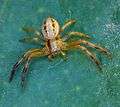Xysticus
| Ground crab spiders | |
|---|---|
 | |
| Xysticus sp. | |
| Scientific classification | |
| Kingdom: | Animalia |
| Phylum: | Arthropoda |
| Class: | Arachnida |
| Order: | Araneae |
| Family: | Thomisidae |
| Genus: | Xysticus L. Koch, 1835 |
| Species | |
|
X. abditus | |
| Diversity | |
| 353 species | |
Xysticus is a genus of ground crab spiders described by C. L. Koch in 1835, belonging to the order Araneae, family Thomisidae. The genus name is derived from the Ancient Greek root xyst, meaning "scraped, scraper".
Distribution
The genus Xysticus is distributed almost worldwide, but has not been recorded from South America. Of the about 360 species of the genus currently described, about 71 are present in Europe.
Description
Xysticus and Coriarachne are dark brown or reddish-brown crab spiders often encountered on weeds or trees. While similar to the 'flower spiders', they tend to have shorter, sturdier legs. Many, but not all, species have abdomens more patterned than most Thomisus species, rather like some of the Synema species. Some however, that are more terrestrial, resemble earth in colour and texture.
Most species of the genus Xysticus are small to medium sized spiders. They show a sexual dimorphism in size. Females of typical species reach a maximum of 10 millimetres (0.39 in) of body length, while their males are about 3–5 millimetres (0.12–0.20 in) long, about half the size of the females.
The basic colour of these species is usually brown, beige or gray. The prosoma is sometimes slightly smaller than the opisthosoma. In many species the front body shows in the middle a broad, pale longitudinal band. The opisthosoma is clearly flattened in most species and shows a median broad and dark leaf marking.
The species are often very similar to each other, and in most cases can be distinguished only by a microscopic examination of the reproductive organs.
Behaviour
The spiders of the genus Xysticus do not build webs; like most Thomisidae they are ambush hunters and prefer to hunt near the ground (hence the common name "ground crab spiders"). They move slowly, and commonly hunt by stationing themselves in a high-traffic area and grabbing whatever arthropod passes close enough. Also like most other Thomisidae, they seize prey with their enlarged anterior two pairs of legs and kill it by a venomous bite.
Gallery
- Xysticus species, female
- Xysticus species, male
- Xysticus species
 Xysticus species
Xysticus species Xysticus audax
Xysticus audax Xysticus kochi, female
Xysticus kochi, female Xysticus cristatus
Xysticus cristatus Xysticus bilimbatus
Xysticus bilimbatus Xysticus lanio
Xysticus lanio Xysticus luctator
Xysticus luctator Xysticus ninniii
Xysticus ninniii Xysticus ulmi
Xysticus ulmi.jpg) Xysticus robustus (Hahn, 1832) from Hiiumaa, Estonia
Xysticus robustus (Hahn, 1832) from Hiiumaa, Estonia- Xysticus species
- Xysticus species eating a beetle
References
- Norman I. Platnick - Thomisidae
- J. H. Redner and C. D. Dondale - A New Species of The Spider Genus Xysticus (Araneae: Thomisidae) From Arizona - PsycheVolume 72 (1965), Issue 4, Pages 291-294
- H. Demir, O. Seyyar, and M. Aktaş - A Poorly Known Species of the Spider Genus Xysticus C. L. Koch (Araneae, Thomisidae) in Turkey - Arch. Biol. Sci., Belgrade, 60 (4), 17P-18P, 2008
External links
![]() Data related to Xysticus at Wikispecies
Data related to Xysticus at Wikispecies
![]() Media related to Xysticus at Wikimedia Commons
Media related to Xysticus at Wikimedia Commons
- Pictures of Xysticus triguttatus (free for noncommercial use)
- Xysticus BugGuide
- Greennature